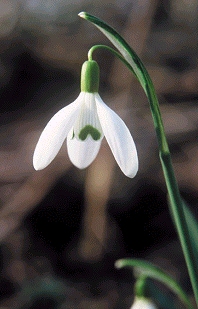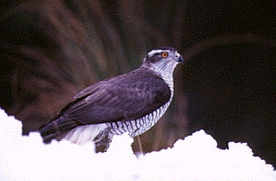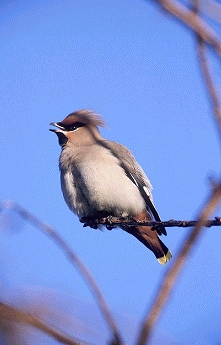Dyddiadur Ceidwad Cefn Gwlad
Mis Ionawr
Mae'r ymgyrch i oroesi yn codi gêr wrth i fwyd ddod yn brinach ac yn anos ei ganfod. Gydag ond ychydig o ddail i'w gweld mae'r tirwedd sy'n ymddangos yn ddiffrwyth, yn gallu eich synnu ag arwyddion o fywyd.
Beth sydd o gwmpas yn Ionawr?
 Mae grifft llyfaint yn un o'r arwyddion cyntaf fod y gwanwyn yn agosáu
Mae grifft llyfaint yn un o'r arwyddion cyntaf fod y gwanwyn yn agosáu- Mae dail yr eirlysiau yn ymddangos drwy'r pridd, eu pigau tew yn eu darparu ag arwyneb amddiffynnol wrth iddynt wthio i fyny drwy'r pridd sydd wedi rhewi. Erbyn diwedd y mis dylai'r blodau cyntaf ymddangos.
- Tuag at ddiwedd y mis bydd y sgwarnogod yn dechrau eu carwriaethau.
- Adar ysglafaethus. Mae tyfiant prin y gaeaf yn ei gwneud yn haws gweld 'blociau'r cigydd' neu byst gwylio adar ysglyfaethus fel y gweilch Marthin a'r gweilch glas. Edrychwch am fonion amlwg, carreg frig greigiog a physt ffensiau wedi'u gorchuddio â gwaed a phlu.
 Mae gan y gwalch glas a'r gwalch Marthin prinach, broffiliau trawiadol fel ei gilydd. Mae eu plu cynffon hir a'u hadenydd byr a chrwn wedi'u dylunio er mwyn gallu gwneud llawer o symudiadau a hela mewn hyrddiadau byr a sydyn. Maent yn addas iawn ar gyfer hedfan mewn deiliach tew. Gyda phoblogaeth yn y DU o fwy na 30,000 y gwalch glas yw un o'r adar ysglyfaethus mwyaf niferus, yn ail i'r cudyll coch.
Mae gan y gwalch glas a'r gwalch Marthin prinach, broffiliau trawiadol fel ei gilydd. Mae eu plu cynffon hir a'u hadenydd byr a chrwn wedi'u dylunio er mwyn gallu gwneud llawer o symudiadau a hela mewn hyrddiadau byr a sydyn. Maent yn addas iawn ar gyfer hedfan mewn deiliach tew. Gyda phoblogaeth yn y DU o fwy na 30,000 y gwalch glas yw un o'r adar ysglyfaethus mwyaf niferus, yn ail i'r cudyll coch.
- Ditectifs mamaliaid. Canfyddwch fan twmpathog mewn parc i ffwrdd o'r mannau lle bu'r ceirw'n pori. Os tynnwch y glaswellt bras tew yn ôl a thyrchu i lawr i'r gwreiddiau 'rydych yn siwr o ddod ar draws twneli y llygod cyffredin a llygod pengrwn y gwair. Caiff y twneli hyn eu hamddiffyn a'u patrolio'n gryf yn y tymor bridio, ond nawr, bwyd yw'r flaenoriaeth. Mae pentyrrau o faw ffres mewn mannau domi a thasau o ddarnau gwair sy'n edrych fel petaent wedi cael eu torri gan siswrn yn nodi presenoldeb llygod pengrwn.
- Coed ynn marw yw'r llefydd gorau i edrych am gyrff hadol sgleiniog y ffwng Daldinia concentrica, Cacennau'r Brenin Alfred neu'r belen ddu. Tra bod y mwyafrif o gaws llyffant yn bwrw'u sborau drwy eu gollwng yn syml i'r awyr, mae'r ffwng pren hwn yn eu saethu'n dreisgar. Dewch ag un i le cynnes a'i osod dan lamp bwrdd, edrychwch gyda chwyddwydr a gallwch weld y ffrwydrau powdrog ar draws yr arwyneb yn hawdd. Mae'r sborau yn cael eu saethu allan gan bwysedd mewn asgi siâp fflasg sydd wedi'u plannu ar arwyneb y ffwng.
 Yn y pinc
Yn y pinc
Yn y mis nesaf neu ddau dylem wybod p'un a yw hwn yn 'aeaf aden gwyr' - blwyddyn pan fo tywydd gwael yn gyrru heidiau o'r adar hardd yma allan o Sgandinafia a thraw i Brydain i chwilio am fwyd. Gyda'u cribau pinc a'r darnau coch ar eu hadenydd cwyr, gall yr adar hyn ddod â chip ar yr egsotig i ddiwrnod diflas. Gellir gweld heidiau crwydrol yn chwilio am fwyar. Nid ydym erioed wedi cael cofnod o aden gwyr yn y parc, ond maent wedi'u gweld mewn blynyddoedd cynt ym Mhorthcawl a'r Pîl. Croeswch eich bysedd eleni; mae'n braf cadw eich llygaid yn agored am y rhywogaethau mwyaf anarferol. Os gwelwch rywbeth nad ydych yn siwr ohono, gadewch i ni wybod.